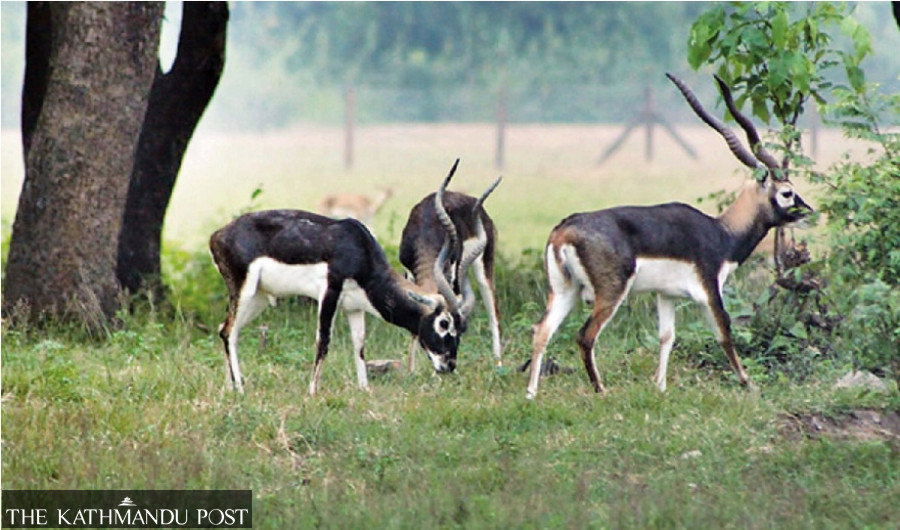Climate & Environment
Blackbuck population declines in Bardiya’s Blackbuck Conservation Area
Attacks from leopards and hyenas threaten the survival of the near-threatened species.
Kamal Panthi
As many as 85 blackbucks died in Khairapur, Bardiya in the last fiscal year 2020/2021, worrying conservationists about the survival of the near-threatened species in the Blackbuck Conservation Area.
“Sixty-five blackbucks (Antilope cervicapra) were killed by leopards while others were killed by jackals and hyenas. Some died of natural causes,” said Manaraj Lama Moktan, the ranger at the Blackbuck Conservation Area.
According to him, three blackbucks were killed by leopards in the first three months of the current fiscal year.
The employees deployed in the Blackbuck Conservation Area in Gulariya Municipality, Bardiya have been unable to protect the species from predators in the wild.
Blackbucks are listed as a near-threatened species by the International Union for Conservation of Nature.
Leopards from Tulsipur and Bechaipur community forests enter the conservation area to prey on blackbucks.
“Leopards are the major threat to the survival of blackbucks,” said Moktan.
According to the Blackbuck Conservation Area, there were a total of 300 blackbucks in the area three years ago. There are currently 170 blackbucks, including 112 females, 43 males and 15 fawns. The employees of the conservation area have warned that the blackbucks will become extinct within a few years if they are not protected from leopard attacks.
The Blackbuck Conservation Area spreads over 479 hectares of land in Gulariya Municipality-2 of Bardiya. The government officially declared the area as ‘Blackbuck Conservation Area’ in 2009 with an objective to preserve the deer species.
According to conservationists, around 50 blackbuck deaths are reported each year and most of them are attributed to leopard attacks. Hyenas, jackals and stray dogs are the other predators that prey on the blackbucks.
It is speculated that there are four leopards in the protected forests of Tulsipur and Bechaipur. A leopard had been trapped and moved to Bardiya National Park three years ago to control attacks on blackbucks.
“The blackbuck population has been on a decline because of leopard attacks. The leopards are not only a threat to blackbucks but also to domestic animals,” said Tanka Adhikari, the ward chairman of Gulariya-2.
According to Adhikari, officials at the Blackbuck Conservation Area have done little to nothing to prevent the deer species from moving towards extinction.
A female blackbuck generally gives birth to two fawns a year. Conservationists believe that the blackbuck population would reach around 300 if they are protected from wild animals.
Shortages of water and shrinking of grazing land are other causes for the declining population of blackbucks. “The conservation area has not managed infrastructure for the safe habitation for blackbucks,” said Adhikari.
The Blackbuck Conservation Area had built barbed fencing around 10 kilometres of its area at the cost of Rs 20 million eight years ago. But the fence has been damaged in several places, allowing leopards, hyenas and other animals to easily enter the conservation area.
The office of Blackbuck Conservation Area said that it had requested the Department of National Parks and Wildlife Conservation, the National Trust for Nature Conservation and other concerned authorities to control the leopards that prey on blackbucks and move them to other locations.
“But the concerned authorities have not paid much attention to resolve the problem,” said Moktan.
Rabin Kadariya, chief at the Bardiya office of National Trust for Nature Conservation, said the Blackbuck Conservation Area had requested it to take initiatives to control the leopards in the area and protect the blackbuck species.
“We have taken the issue seriously. Discussions are ongoing among the concerned authorities to shift the leopards to other locations,” said Kadariya.




 6.84°C Kathmandu
6.84°C Kathmandu










